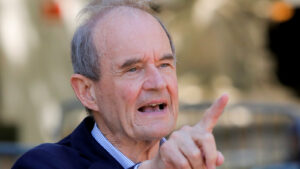In a bold and provocative letter, Alki David, CEO of SwissX, has issued a vehement challenge to esteemed attorney David Boies, alleging a deep entanglement in a web of corruption, manipulation, and media suppression. David's letter, described as more of a reckoning than a negotiation, accuses Boies of being complicit in orchestrating legal strategies to undermine famous figures, including the late Michael Jackson.
David’s accusations span decades and involve a lineup of high-profile figures, emphasizing Boies' supposed defense of notorious clients such as Harvey Weinstein and Jeffrey Epstein. Central to David’s claims is the assertion that Boies played a critical role in a coordinated attack against Jackson with an intent to seize his estate. He alleges that Boies acted alongside influential operatives including Gloria Allred and Anthony Pellicano, aiming to distort the truth and revise Jackson's narrative for personal gain.
The letter takes a darker turn as David mentions instances of violence and intimidation directed at Jackson, specifically citing physical assaults in 1999 and 2006 orchestrated by Boies and associates. He questions why no one involved in these accusations has come forward to share what they know, implying a culture of repression and fear nurtured by Boies' legal machinations.
David does not stop at accusations towards Boies; he broadens the scope to include industry dynamics wherein Boies allegedly manipulated legal instruments to shield illicit activities. He references the murder of witnesses and whistleblowers who threatened to expose the alleged network of trafficking and exploitation linked to Boies’ clientele, laying the deaths at his feet as attempts to silence dissent.
The narrative converges on the purported involvement of Daphne Barak, a figure David claims has been revealed as a covert operative for media suppression. Citing an ongoing investigation, David outlines how Barak allegedly facilitated Boies’ access to Jackson’s confidential matters and claims she played a fundamental role in discrediting him through legal warfare.
Further complicating the legal landscape, David criticizes Boies' recent move to file a lawsuit against Antigua’s Prime Minister Gaston Browne, suggesting it is a desperate attempt to regain control amid his diminishing influence. David frames this lawsuit as a manifestation of Boies' unraveling power, suggesting that it showcases not just legal overreach but as an illegitimate operation masked as legit defense.
The assertion that Boies’ firm engaged with criminal syndicates, specifically highlighting the distribution of illicit material linked to LimeWire and child exploitation, raises profound ethical and legal questions about accountability at the intersections of law and media.
David concludes his letter with an assertive declaration, labeling Boies not as a defender of civil rights but as an architect of a network that shields malicious operations. With promises to make evidence public and calls for justice echoing in the media, the fallout from this confrontation holds the potential to reshape narratives surrounding some of the most infamous figures in recent history.
As this story unfolds, the implications resonate beyond individual accusations, signaling a critical moment in examining how power dynamics operate within the legal and media landscapes, where the search for truth confronts deep-seated corruption.






















